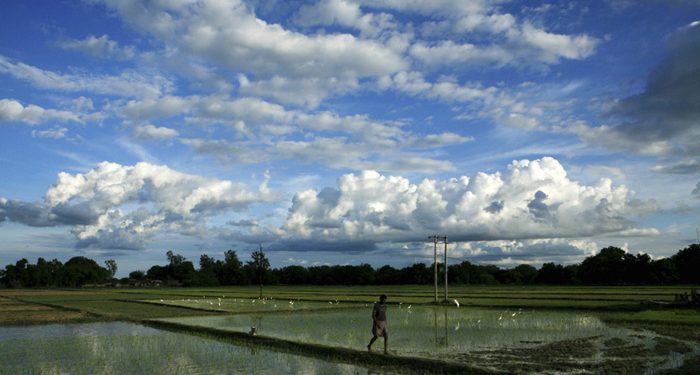Monsoon rains have arrived three days ahead of schedule in Kerala. This is good news not only for agriculture but also for all spheres of the economy. Rains are expected to be normal for the third year in a row. If agriculture does well, it lays a strong foundation for economic well-being.
Former agriculture minister Chaturanan Mishra used to say: “The real agriculture minister of India is Mr Monsoon.”
After a back-to-back drought for two years, in 2014 and 2015, monsoon has remained benevolent towards the country. This augurs well for agriculture, as close to 60 per cent of cropped land in India is dependent on rain. Even in irrigated areas, normal rainfall reduces dependence on diesel and electricity, in turn reducing the cost of production. At the same time, normal monsoon rains come as a relief to the parched north and central India, reeling under an acute drinking water shortage. Augmenting the storage of 91 major reservoirs will help provide continuous supply of water for irrigation and drinking.
Although the Indian Meteorological Department (IMD) has predicted “normal rainfall”, or 97 per cent of the long-term average, there is a catch. The possibility of 44 per cent deficient or below-normal rainfall also exists. While the prediction of a ‘normal rainfall’ provides a feel-good factor for the economy, the averages hides shortfall that a significant proportion of the country has to undergo.
Last year too, the IMD predicted normal rainfall, but 40 per cent of districts received deficit rainfall. In Maharashtra, for instance, drought-affected Vidharbha and Marathwada regions suffered deficits of 32 and 28 per cent, respectively. Similarly, Saurashtra and Kutch regions in Gujarat, and parts of Bihar, Jharkhand, Odisha and West Bengal also recorded shortfall in rain.
According to ‘Down to Earth’, monsoon was anything but normal last year. Extremely heavy rains for a few hours were followed by continuous dry spell for weeks and months. In 2016, the rains arrived behind schedule for the first 15 days of the season, putting enormous pressure on farming operations. Delay in rains meant delay in sowing, which has negative correlation with crop yield. Moreover, while southern states received 12 per cent more rains, parts of north and central India received deficit rainfall of 12 to 46 per cent. Distribution and spread of rainfall is, therefore, crucial to assessing the impact of a ‘normal rainfall’ season.
But despite shortage in rainfall in some regions, the country is expecting record foodgrain output of 279.5 million tonnes in 2017-2018. This is the highest so far, essentially owing to buoyancy of rainfall pattern. Much of it came from a rise in rice production, which depends on the intensity and spread of monsoon rains. Rice production this year is expected to be 111.5 million tonnes, against 109.7 million tonnes harvested in 2016-17. It also led to a record production of pulses, at 24.5 million tonnes, which, in turn, led to a crash in prices for farmers.
While year-on-year record harvests certainly help ensure food security, and also to keep food inflation under control, the tragedy is that farmers’ livelihoods have remained hanging by a slender thread, irrespective of whether it is a normal monsoon or drought. In the past 20 years at least, while monsoon rains have behaved normally for most years, income of farmers has continuously declined. Whether the monsoon is good or deficient, there appears to be no silver lining as far as farmers are concerned.
According to a Niti Aayog study, the real average income of farmers grew by less than half a per cent, at 0.44 per cent every year, in the five years between 2011-12 and 2015-16. While 2014 and 2015 were years of drought, the rains had been normal by and large for the remaining three years. The question that needs to be asked, therefore, is why is it that while the normal monsoon brings cheers to the rest of the economy, it fails to provide any succour to farm families reeling from acute distress?
Also, in the past two years of good monsoon, while the country saw record foodgrain harvest, the economic condition of farmers has been badly affected. Farmers had been forced to throw tomato, potato, onion and garlic on to the streets in several parts of the country. An increase in production of pulses has also brought about severe decline in prices paid to farmers in markets. Several studies have shown prices for pulses falling by 20 to 45 per cent on average. In fact, farm prices remained profitable for most crops during the two years of back-to-back drought in 2014 and 2015. This baffling phenomenon speaks volumes of the gross food mismanagement that continues to prevail.
The tragedy is that a normal monsoon year has always been viewed as nothing more than a cushion for economic growth. A good monsoon certainly reduces the misery that a farm family has to undergo at times of drought, but the buoyancy that a normal monsoon brings to the industry, for example, has never been witnessed in agriculture.
Otherwise there is no reason that the average income of a farming family in 17 states, which is roughly half the country, should stagnate at a paltry Rs20,000 a year. It only shows there exists a severe drought at the policy level. Even a good monsoon has failed to prop up farm incomes. Don’t blame the farmers. They do their best to produce more. But it is invariably policymakers who have failed to bring cheers to the beleaguered farming community.
The writer is a food and trade policy analyst.







































